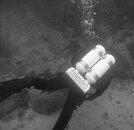You know, people seem to think that the team approach to diving means you have to dive shoulder-to-shoulder and do nothing but check on your team.
It's not like that. For example, I'm thinking of a dive I did off a charter with my friend Kathryn. We both had cameras. We got the dive briefing, went over our own plan, and did our checks. We dropped in the water and started to move slowly along, roughly side-by-side but about 8 feet apart or so. Kathryn found something to photograph, and I saw her position herself for some shots. So I scouted around the general area, looking for something photogenic. I was sometimes behind her, sometimes beside or in front of her, but I never got more than about ten feet away. I took some pictures and paused, noted her strobes were still firing, so I took some more. I looked up and found her looking at me, and it was clear she had finished her pictures, so we meandered a little further. The same scenario was repeated through the dive. We didn't hold a formal formation, and we weren't always in eye contact. What made it work was that both of us intended to stay together, and neither of us was going to do anything unexpected or unpredictable. (Had I seen something utterly fabulous at the edge of my self-imposed wander, I would have flashed her with my light and both of us would have gone to look at it.)
It really isn't that hard to stay together. It just requires a desire to do so, and predictable behavior.





